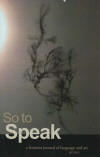So to Speak – Fall 2013
A reader who gets a copy of this issue of So to Speak: a feminist journal of language and art will find that it delivers on the promise of its title. A mix of prose, poetry, and images, this print issue from a well-established publication has beauty, intelligence, and provocation. The journal doesn’t insist on any one definition of feminism, preferring instead to take whatever touches women’s lives as its subject. Anyone who cares about women and/or cares about good art will appreciate it.
A reader who gets a copy of this issue of So to Speak: a feminist journal of language and art will find that it delivers on the promise of its title. A mix of prose, poetry, and images, this print issue from a well-established publication has beauty, intelligence, and provocation. The journal doesn’t insist on any one definition of feminism, preferring instead to take whatever touches women’s lives as its subject. Anyone who cares about women and/or cares about good art will appreciate it.
In an interview with VIDA, journal editor Kate Partridge says she enjoys “finding a piece of writing that expresses feminist ideas in a way that had never occurred to [her].” The pieces I admire the most in this issue do have this sense of unexpectedness about them. The short story, “Sit Still, and I’ll Weave” by Tamar Altebarmakian, does a lovely job exploring the difficulty of being a “good daughter” (or a good niece) to one’s cultural heritage. Whenever the narrator visits her aunt, she must listen to the story of her great-grandfather, a rug-maker who survived the genocide against Armenians in the early twentieth century. While the narrator knows she is supposed to find this story powerful, she doesn’t, and she struggles to embrace the art of the rugs themselves. When her aunt gives her a swatch of rug to keep, she takes it “as gingerly as [she] can and hope[s she looks] awed.” For her, the truth is this: “I don’t really like our rugs. The designs are so intricate that they make my eyes hurt.” This deft, elegant piece of fiction encourages readers to wrestle with the connections between family obligation, history, and gender. While her husband sleeps in a nearby chair with a hookah in his lap, the aunt keeps telling stories to the dutiful niece, suggesting how although men may sometimes be considered the authors of history, it’s women who maintain it.
As for other genres featured in the magazine, I enjoy Lauren Banka’s free-verse poem “Queer is Like.” The poem offers a nuanced meditation on sexuality. It compares being queer to driving, to leaving a green, pastoral environment where “everything is simple” and entering a busy highway that “shouldn’t work at all, so many people shouldn’t be able to move in such complicated ways all the time.” This poem is expansive, giving the reader the idea that discovering difference can be dizzying, fun, and ultimately manageable (the last line: “the road is solid & now & now”).
Stephanie Dickinson’s nonfiction piece, “New Jersey Noir,” takes a new-journalism approach to explore a writer’s fascination with a famous murder case. A young woman goes into New York City for the night and ends up in an apartment with a man and his girlfriend. The man then rapes and murders her, and the girlfriend looks on, seemingly disinterested. The narrator of the piece follows the investigation and exchanges letters with the imprisoned girlfriend. This piece is striking for its gritty, plainspoken tone and its sharp commentary on female relationships; the narrator imagines the murder victim thinking to herself, “nothing really bad can happen with another girl in the room, can it?” When the narrator asks the girlfriend why her own mother—a prostitute and an addict—had children, she makes a guess: “welfare checks.”
So to Speak started in 1993, around the same time I began to identify as a feminist. As I read this issue, I feel a little sad that much of its material deals with two well-worn “women’s topics”: reproduction and male violence. Are these things really the scope of women’s experience? Yet, in a time when patriarchy not only maintains its grip but gets better at concealing itself, it’s crucial to continue to address them. Any scan of Google News shows how literature and art have more work to do to advance women’s causes. I encourage all readers to seek out this important publication, and I can’t wait to see what 2014 brings.
[sotospeakjournal.org]





